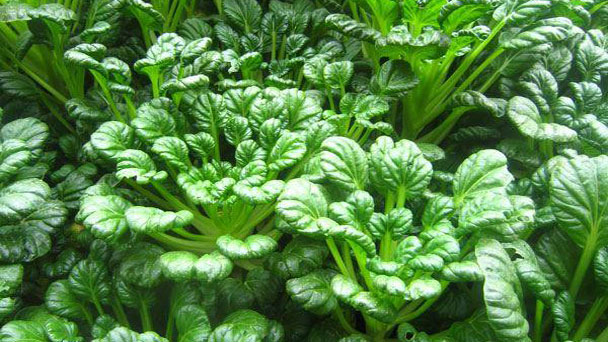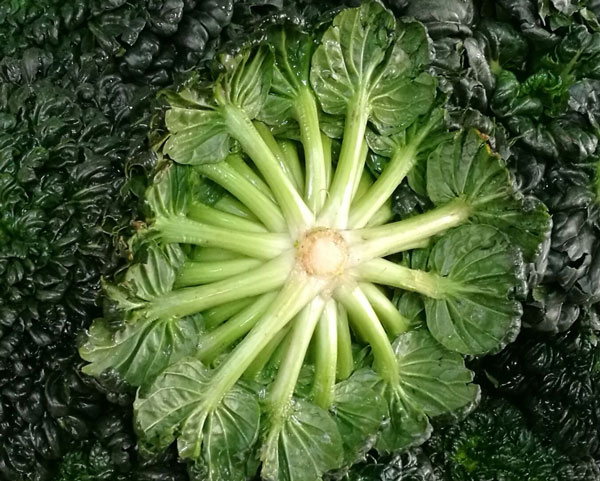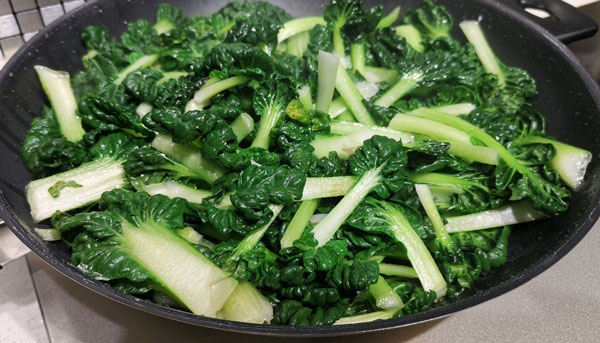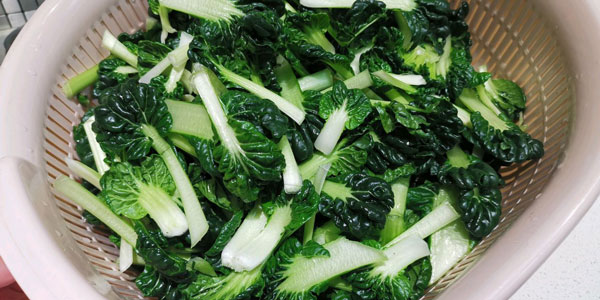Tatsoi: Grow & Care for Mustard Greens
Written by Iris
Oct 11 2021

Tatsoi (Mustard Greens) is a member of the brassica family—along with mustard greens and Brussels sprouts. Tatsoi (Mustard Greens) has rounded leaves shaped like a spoon, which have a buttery texture and a slightly sweet flavor.

Find a full sun to partial shade, area of your garden to plant. Tatsoi prefers well-drained, well-worked, loamy or sandy soils rich in nitrogen. It thrives outdoors in raised beds or in prepared ground soil. If gardening in-ground or in a raised bed is not an option, no problem. It will do well in carefully placed containers indoors and outdoors. If you have to grow Tatsoi indoors, find a south-facing window with plenty of space to place your container.
To sow seed, amend unprepared soil with compost at an average depth of 10 inches. Seeds prefer 50 to 80 degrees to germinate. Create rows ½ to ¼ inches deep, spaced 18 to 24 inches apart. Tatsoi grows outward in a radial fashion, so ensure there aren’t other plants crowded out in that process. Drop seeds in the trench at 1 to 2 inches apart. Seed germination rates are high at 75%, so drop 2-3 per spot. As seedlings mature, thin them to 6 to 8 inches apart. This gives plants plenty of room to grow. Starts mature in 6 weeks.
Plant seedlings in the same temperature conditions you would for seeds but a couple of weeks later, with temperatures between 50 and 80 degrees. Grow tatsoi starts 6 to 8 inches apart, and harvest when leaves are mature — throughout the season until the flowering stage. Starts reach harvest maturity at about 3 weeks.

Tatsoi
You often see this variety listed as tatsoi or as an “Asian green.” Organic Asian Green Seed from Johnny’s Seeds is their generic variety. It forms the traditional compact rosette shape, withstands frost and is great in microgreen mixes.
Koji
This hybrid variety has large, savoyed leaves and is good for bunching, which makes it ideal if you are selling at your local farmer’s market. It's also more heat tolerant than other varieties. Plant 12-inches apart for full-size heads.
Red Cloud
This beautiful hybrid variety grows upright and has burgundy colored leaves. Great for bunching or baby leaf and has a long, tender stem. It adds real color and pizzaz to a winter salad.
Lady Murasaki Asian Green
This tatsoi variety comes from Fedco seeds and is named after Lady Murasaki, a famous Japanese author who wrote in 1000 AD. This is a striking purple, open-pollinated variety that holds its color well. It's also slow to bolt.
Where to Grow TatsoiWhen to Plant Tatsoi Seeds IndoorsWhen to Plant Tatsoi in Your GardenHow to Grow Tatsoi (Mustard Greens)How to Care for Tatsoi (Mustard Greens)Tatsoi Lighting RequirementsTatsoi Soil CareTatsoi WateringTatsoi Temperature & Humidity CareTatsoi Fertilizer CareTatsoi PruningTatsoi Pests & Diseases CareVarieties of Tatsoi (Mustard Greens)Tatsoi (Mustard Greens) FAQWhat Does Tatsoi (Mustard Greens) Taste Like?How long does tatsoi take to grow?Can tatsoi grow in shade?
Where to Grow Tatsoi
First of all, select a good location in your home garden for growing tatsoi. Tatsoi plants grow well in full sun with good drainage system. So, select a good location in your garden with full sun and good drainage system.When to Plant Tatsoi Seeds Indoors
Growing tatsoi from seed for your garden requires patience. You will want to start seeds at least four weeks before the last date of frost. The best way to start seeds is in trays or biodegradable seed starting cups. You can transplant seedlings after the last frost, but you should avoid planting too soon. Seedlings that experience excessive cold early may quickly bolt.When to Plant Tatsoi in Your Garden
Tatsoi is easy to direct-seed in your garden. You can start the seeds on the last day of frost in the spring or toward the end of summer for a second fall harvest. To sow seeds in your garden, make a shallow trough about one-quarter inch deep and loosely sprinkle the tiny seeds. Cover lightly with soil and moisten, but don't flood. Seeds will germinate in about one week but may take several weeks to sprout fully.
How to Grow Tatsoi (Mustard Greens)
Sow seed outdoors two weeks before the last frost, or at the start of fall six weeks before the first frost. Avoid planting seeds or seedlings in late spring and summer. Tatsoi is not suited for warm conditions. It thrives in the cool late spring. Once summer hits, your first round of crops is done. Heat causes bolting and flowering, which makes tatsoi bitter in flavor. Harvest in spring, and grow another set of crops in the beginning of fall up to winter for a second fall harvest.Find a full sun to partial shade, area of your garden to plant. Tatsoi prefers well-drained, well-worked, loamy or sandy soils rich in nitrogen. It thrives outdoors in raised beds or in prepared ground soil. If gardening in-ground or in a raised bed is not an option, no problem. It will do well in carefully placed containers indoors and outdoors. If you have to grow Tatsoi indoors, find a south-facing window with plenty of space to place your container.
To sow seed, amend unprepared soil with compost at an average depth of 10 inches. Seeds prefer 50 to 80 degrees to germinate. Create rows ½ to ¼ inches deep, spaced 18 to 24 inches apart. Tatsoi grows outward in a radial fashion, so ensure there aren’t other plants crowded out in that process. Drop seeds in the trench at 1 to 2 inches apart. Seed germination rates are high at 75%, so drop 2-3 per spot. As seedlings mature, thin them to 6 to 8 inches apart. This gives plants plenty of room to grow. Starts mature in 6 weeks.
Plant seedlings in the same temperature conditions you would for seeds but a couple of weeks later, with temperatures between 50 and 80 degrees. Grow tatsoi starts 6 to 8 inches apart, and harvest when leaves are mature — throughout the season until the flowering stage. Starts reach harvest maturity at about 3 weeks.

How to Care for Tatsoi (Mustard Greens)
Tatsoi Lighting Requirements
Tatsoi grows best in partial sun; about three to five hours each day is ideal but it can handle full sun if it is kept well watered.Tatsoi Soil Care
Like many brassica plants, tatsoi will grow in various soil types and conditions but prefers well-draining, nitrogen-rich soil that doesn’t compact easily. Tatsoi likes plenty of organic compost for the most vigorous growth. When grown as a row crop, you should make shallow furrows to either side of the plants to encourage drainage and healthy root growth.Tatsoi Watering
These plants are relatively thirsty, particularly in hot regions where the soil dries quickly. You should water tatsoi regularly and make sure the soil is kept moderately moist but not wet. Don't let the soil dry out between waterings, either, because the plant will stress and shorten the harvest. Like many of its cousin species you may already grow, watering should be done around the plants’ roots, not on the leaves. In humid climates, water on the leaves can be a recipe for diseases that can quickly kill tatsoi plants.Tatsoi Temperature & Humidity Care
Tatsoi plants are biennial and may survive undercover in USDA hardiness zones 4 through 7; however, they will quickly bolt to seed in the spring. These greens grow best in temperatures from 60 to 70 degrees Fahrenheit and may bolt if the temperature drops to 50 degrees Fahrenheit.Tatsoi Fertilizer Care
The tatsoi plants are not among the heavy feeders. They will grow just fine if you already have prepared the soil by adding lots of organic materials into it. Applying additional fertilizers is not required.Tatsoi Pruning
Remove damaged or browning foliage from the rosette as they appear. Check daily to ensure damage to tatsoi is not related to fungal or insect pests. As tatsoi plants bolt in warm weather, remove any flowers and add them to a salad or eat them raw. Bolts are a sign the life cycle is completing. However, leaves can still be harvested up until the season is over if tatsoi bolts. The mustard flavor of tatsoi decreases into bitterness at the point of flowering.Tatsoi Pests & Diseases Care
Tatsoi is a favorite of pests. Common pests include cabbage worms, slugs, leaf hoppers and caterpillars. The key to controlling pests is early detection. Regularly check the core of the plant if there are visible signs of pest infestation, like insect poop or larvae eggs. Spray a neem-based solution once a week to prevent or eradicate pests, applying it generously on the top and bottom leaves, as well as the stems. The plant can still be revived even if most of the leaves are destroyed by pests. Cut the infected leaves, leaving around 2 inches at the bottom. It will grow back its full leaves in about 2-3 weeks.
Varieties of Tatsoi (Mustard Greens)
Be careful when you are looking for Tatsoi seeds to grow. Many times it is confused with bok choi or mizuna because they are closely related. Remember to watch for the scientific name which is (Brassica rapa subsp. Narinosa). The subspecies is the important part since related species is Brassica rapa.Tatsoi
You often see this variety listed as tatsoi or as an “Asian green.” Organic Asian Green Seed from Johnny’s Seeds is their generic variety. It forms the traditional compact rosette shape, withstands frost and is great in microgreen mixes.
Koji
This hybrid variety has large, savoyed leaves and is good for bunching, which makes it ideal if you are selling at your local farmer’s market. It's also more heat tolerant than other varieties. Plant 12-inches apart for full-size heads.
Red Cloud
This beautiful hybrid variety grows upright and has burgundy colored leaves. Great for bunching or baby leaf and has a long, tender stem. It adds real color and pizzaz to a winter salad.
Lady Murasaki Asian Green
This tatsoi variety comes from Fedco seeds and is named after Lady Murasaki, a famous Japanese author who wrote in 1000 AD. This is a striking purple, open-pollinated variety that holds its color well. It's also slow to bolt.

Tatsoi (Mustard Greens) FAQ
What Does Tatsoi (Mustard Greens) Taste Like?
The best way to describe tatsoi's flavor is to say that it is most similar to tender baby bok choy leaves. It's slightly sweeter, and the stalks have a cucumber-like pleasant bitterness. The flavor is more earthy and rich than many brassica varieties and has a mild mustard green taste.How long does tatsoi take to grow?
Tatsoi grows from seed to full maturity in 45 days. Starts mature in 20-25 days.Can tatsoi grow in shade?
Tatsoi prefers partial shade, but full shade will stunt plant growth. Ensure tatsoi has at least 3-5 hours of full sun per day. Too much more causes tatsoi to bolt and lose flavor over time.Latest Updated
- Benefits of Bugleweed - 7 Science-backed Health Benefits
- Bugleweed Dangers & Side Effects - Is It Poisonous?
- How to Plant Evergreen Trees - What You Should Know
- When to Plant Evergreens - Grow Guide for Evergreen Trees
- 12 Wonderful Evergreen Shrubs for Your Garden
- 12 Popular Evergreen Plants with Pictures for Beginners
- When And How To Prune A Lilac Bush Like a Pro
- How to Grow & Care for Lilac Vine (Hardenbergia Violacea)
- Japanese Lilac Tree (Syringa Reticulata) Care & Propagation Guide
- Shumard Oak Pros and Cons - What to Know
Popular Articles
- Winter maintenance of Antirrhinum Majus
- How to Grow Terminalia Mantaly Tree
- How to Grow and Care for Crossostephium Chinense
- How to grow Antirrhinum Majus in spring
- Peristeria Elata (Dove Orchid) Profile: Info & Care Guide
- Underwatered Snake Plant (Sansevieria Trifasciata) - Signs And How To Fix
- How to Care for Brazilian Jasmine Plant (Mandevilla Sanderi)
- How to Grow & Care for Graptopetalum Purple Delight in Summer
- Rosa Chinensis (China Rose): Plant Growing & Care Tips
- How to Care for Baby Sun Rose (Aptenia Cordifolia)